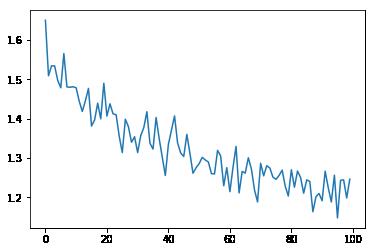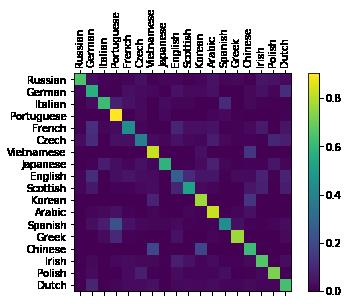使用字符级的RNN做姓名分类
Posted 爆浆大鸡排
tags:
篇首语:本文由小常识网(cha138.com)小编为大家整理,主要介绍了使用字符级的RNN做姓名分类相关的知识,希望对你有一定的参考价值。
原文:CLASSIFYING NAMES WITH A CHARACTER-LEVEL RNN
翻译:Jerry
日期:2019-01-24
Preparing the Data
从此处下载数据,将txt文件解压至同目录的data/names下
数据集共有18个文本文件,命名规则是“[语种].txt”。文件内容每一行是一个姓名,许多是罗马字母(但是我们需要将其从Unicode转换为ASCII格式)
首先我们构建一个语种-姓名的字典 languages: [names ... ]。变量“category”和“line”对应文件的“语种”和“姓名”
from __future__ import unicode_literals, print_function, division
from io import open
import glob
import os
def findFiles(path):
return glob.glob(path)
print("data:", findFiles('data/names/*.txt'))
import unicodedata
import string
all_letters = string.ascii_letters + " .,:'"
n_letters = len(all_letters)
# 将Unicode字符串转换成ASCII:https://stackoverflow.com/a/518232/2809427
def unicodeToAscii(s):
return ''.join(
c for c in unicodedata.normalize('NFD', s)
if unicodedata.category(c) != 'Mn'
and c in all_letters
)
print("Ślusàrski => " , unicodeToAscii("Ślusàrski"))
# 构建 category_lines 字典,每一种语言的名字列表
category_lines =
all_categories = []
def readLines(filename):
lines = open(filename, encoding='utf-8').read().strip().split("\\n")
return [unicodeToAscii(line) for line in lines]
for filename in findFiles('data/names/*.txt'):
category = os.path.splitext(os.path.basename(filename))[0]
all_categories.append(category)
lines = readLines(filename)
category_lines[category] = lines
n_categories = len(all_categories)
Out:
data: ['data/names/Russian.txt', 'data/names/German.txt', 'data/names/Italian.txt', 'data/names/Portuguese.txt', 'data/names/French.txt', 'data/names/Czech.txt', 'data/names/Vietnamese.txt', 'data/names/Japanese.txt', 'data/names/English.txt', 'data/names/Scottish.txt', 'data/names/Korean.txt', 'data/names/Arabic.txt', 'data/names/Spanish.txt', 'data/names/Greek.txt', 'data/names/Chinese.txt', 'data/names/Irish.txt', 'data/names/Polish.txt', 'data/names/Dutch.txt']
Ślusàrski => Slusarski
现在我们有了category_lines,它保存了语种-姓名列表。同时我们也有all_categories,保存了语种列表,以及n_categories表示语种的数量
print(category_lines['Italian'][:5])
Out:
['Abandonato', 'Abatangelo', 'Abatantuono', 'Abate', 'Abategiovanni']
将名字转换成Tensor
我们现在有了结构化的名字数据,现在我们需要将其转换成Tensor才能使用
文本的表示有很多方法,这里我们使用“独热编码”(one-hot)表示一个字母。独热码是指维度是 <1 x n_letters> 的向量,向量所有位置上的值都是0,只有在对应字母的索引位置上的值是1。比如字母 b 在索引是1,则独热码为: [ 0 1 0 0 ... ]
为了表示一个名字,我们需要一个2D矩阵 <ling_length x 1 x n_letters>
这额外的 1 个维度被保留下来,是因为PyTorch假定所有东西都是批量的,我们只是使用了批量的大小为1
import torch
# 找到字母在字母表中的位置。比如 'a' = 0
def letterToIndex(letter):
return all_letters.find(letter)
# 独热编码,一个 <1 x n_letters> 的Tensor
def letterToTensor(letter):
tensor = torch.zeros(1, n_letters)
tensor[0][letterToIndex(letter)] = 1
return tensor
# 将一行文本转换成 <line_length x 1 x n_letters> 的Tensor
# 或者是一个独热码的数组
def lineToTensor(line):
tensor = torch.zeros(len(line), 1, n_letters)
for li, letter in enumerate(line):
tensor[li][0][letterToIndex(letter)] = 1
return tensor
print(letterToTensor('J'))
print(lineToTensor('Jones').size())
Out:
tensor([[0., 0., 0., 0., 0., 0., 0., 0., 0., 0., 0., 0., 0., 0., 0., 0., 0., 0.,
0., 0., 0., 0., 0., 0., 0., 0., 0., 0., 0., 0., 0., 0., 0., 0., 0., 1.,
0., 0., 0., 0., 0., 0., 0., 0., 0., 0., 0., 0., 0., 0., 0., 0., 0., 0.,
0., 0., 0.]])
torch.Size([5, 1, 57])
构建网络
在进行autograd之前,我们需要使用PyTorch构建循环神经网络,在这神经网络中我们需要在一些时间步上共享参数。神经元保存了隐层状态和梯度,完全由计算图本身来处理。这意味着只需要以非常“纯粹”的方式实现RNN,就把它当做是前向传播中的一层
这个RNN模块只有两个线性层,分别操作输入和隐藏状态,得到输出后再经过LogSoftmax层
RNN的神经元结构如下:

import torch.nn as nn
class RNN(nn.Module):
def __init__(self, input_size, hidden_size, output_size):
super(RNN, self).__init__()
self.hidden_size = hidden_size
self.i2h = nn.Linear(input_size + hidden_size, hidden_size)
self.i2o = nn.Linear(input_size + hidden_size, output_size)
self.softmax = nn.LogSoftmax(dim=1)
def forward(self, input, hidden):
combined = torch.cat((input, hidden), 1)
hidden = self.i2h(combined)
output = self.i2o(combined)
output = self.softmax(output)
return output, hidden
def initHidden(self):
return torch.zeros(1, self.hidden_size)
n_hidden = 128
rnn = RNN(n_letters, n_hidden, n_categories)
我们需要给定输入(当前字符)和以前的隐藏状态(初始是全0)。然后我们拿到输出(每一个语种的概率)和下一个隐藏状态(给下一个时间步用)
input = letterToTensor('A')
hidden = torch.zeros(1, n_hidden)
output, next_hidden = rnn(input, hidden)
为了提高效率,我们不希望为每一个时间步都创建一个新的Tensor,所以我们使用 lineToTensor 而不是 letterToTensor。这可以被Tensor的批量预计算进一步的优化
input = lineToTensor('Albert')
hidden = torch.zeros(1, n_hidden)
output, next_hidden = rnn(input[0], hidden)
print(output)
Out:
tensor([[-2.8619, -2.9139, -2.8839, -2.9897, -2.9166, -2.9055, -2.8508, -2.9507,
-2.8785, -2.8848, -2.8242, -2.9322, -2.9182, -2.8118, -2.8402, -2.8435,
-2.9021, -2.9372]], grad_fn=<LogSoftmaxBackward>)
训练网络
在训练之前,我们先构建几个函数。首先是从输出的归一化概率中提取出预测类标。我们使用 Tensor.topk 可以完成这一工作。
def categoryFromOutput(output):
top_n, top_i = output.topk(1)
category_i = top_i[0].item()
return all_categories[category_i], category_i
print(categoryFromOutput(output))
Out:
('Greek', 13)
接着是从训练数据中随机取出一个样本(姓名和它的语种)
import random
def randomChoice(l):
return l[random.randint(0, len(l) - 1)]
def randomTrainingExample():
category = randomChoice(all_categories)
line = randomChoice(category_lines[category])
category_tensor = torch.tensor([all_categories.index(category)], dtype=torch.long)
line_tensor = lineToTensor(line)
return category, line, category_tensor, line_tensor
for i in range(10):
category, line, category_tensor, line_tensor = randomTrainingExample()
print('category =', category, '/ line =', line)
Out:
category = Scottish / line = Boyle
category = Japanese / line = Tokuda
category = Japanese / line = Mishima
category = Italian / line = Ganza
category = Czech / line = Blazek
category = Scottish / line = Reid
category = Vietnamese / line = Bach
category = Portuguese / line = Henriques
category = Italian / line = Nave
category = Spanish / line = Fierro
现在训练这个神经网络只需要输入一些样本数据,让它进行预测,如果预测错了就告诉它(有监督学习)
对于损失函数,我们使用 nn.NLLLoss,因为RNN的最后一层是 nn.LogSoftmax
criterion = nn.NLLLoss()
每一个循环中,训练的步骤是:
- 创建输入和真实值Tensor
- 创建0初始的隐藏层状态
- 读取一个字符,并且保存隐藏状态给下一个字符用
- 对比输出和真实值
- 反向传播
- 返回输出和损失值
lr = 5*1e-3
def train(category_tensor, line_tensor):
hidden = rnn.initHidden()
rnn.zero_grad()
for i in range(line_tensor.size()[0]):
output, hidden = rnn(line_tensor[i], hidden)
loss = criterion(output, category_tensor)
loss.backward()
# 用梯度*学习率来更新权重
for p in rnn.parameters():
p.data.add_(-lr, p.grad.data)
return output, loss.item()
现在我们只需要在数据上跑起来即可。因为 train 函数返回的是输出和损失,所以我们能实时的看到训练过程中loss的变化,也可以画出来。因为我们有1000多个样本,所以我们每隔 print_every 个样本时就显示一次平均loss。
import time
import math
n_iters = 100000
print_every = 5000
plot_every = 1000
# 记录loss
current_loss = 0
all_losses = []
def timeSince(since):
now = time.time()
s = now - since
m = math.floor(s / 60)
s -= m * 60
return '%dm %ds' % (m, s)
start = time.time()
for iter in range(1, n_iters + 1):
category, line, category_tensor, line_tensor = randomTrainingExample()
output, loss = train(category_tensor, line_tensor)
current_loss += loss
# 打印迭代次数,损失,姓名和预测值
if iter % print_every == 0:
guess, guess_i = categoryFromOutput(output)
correct = '✓' if guess == category else '✗ (%s)' % category
print('%d %d%% (%s) %.4f %s / %s %s' % (iter, iter / n_iters * 100, timeSince(start), loss, line, guess, correct))
# 将本次损失记录下来
if iter % plot_every == 0:
all_losses.append(current_loss / plot_every)
current_loss = 0
Out:
5000 5% (0m 8s) 4.5720 Weichert / German ✗ (Czech)
10000 10% (0m 16s) 2.8925 Mclellan / Scottish ✗ (English)
15000 15% (0m 24s) 1.0124 Miller / Scottish ✓
20000 20% (0m 32s) 0.9201 Hodowal / Czech ✓
25000 25% (0m 40s) 0.9193 Woo / Chinese ✗ (Korean)
30000 30% (0m 48s) 3.8676 Ling / Chinese ✗ (English)
35000 35% (0m 56s) 1.1872 Lennard / English ✓
40000 40% (1m 4s) 1.7544 Spiker / Czech ✗ (Dutch)
45000 45% (1m 12s) 1.0265 Totah / Arabic ✓
50000 50% (1m 19s) 0.2883 Dang / Vietnamese ✓
55000 55% (1m 27s) 0.6902 Sarno / Italian ✓
60000 60% (1m 34s) 1.0252 Hladky / Russian ✗ (Czech)
65000 65% (1m 42s) 1.1306 Cardozo / Portuguese ✓
70000 70% (1m 50s) 1.9546 Kennedy / English ✗ (Irish)
75000 75% (1m 58s) 1.3734 Kasamatsu / Greek ✗ (Japanese)
80000 80% (2m 5s) 1.0530 Gil / Chinese ✗ (Korean)
85000 85% (2m 13s) 1.3896 Zee / Chinese ✗ (Dutch)
90000 90% (2m 21s) 0.0017 Chrysanthopoulos / Greek ✓
95000 95% (2m 29s) 1.2594 Nam / Vietnamese ✗ (Korean)
100000 100% (2m 37s) 1.5061 Rapp / Dutch ✗ (German)
展示结果
all_losses 里保存了训练过程中的loss值,我们将它打印出来:
import matplotlib.pyplot as plt
import matplotlib.ticker as ticker
plt.figure()
plt.plot(all_losses)
plt.show()
Out:

评估结果
为了查看网络在不同语种上的表现,我们需要创建混淆矩阵,行表示真实语种,列表示预测语种。使用 evaluate() 函数获取网络的预测值。
# 记录混淆矩阵中正确预测的数量
confusion = torch.zeros(n_categories, n_categories)
n_confusion = 10000
# 给出姓名的预测值
def evaluate(line_tensor):
hidden = rnn.initHidden()
for i in range(line_tensor.size()[0]):
output, hidden = rnn(line_tensor[i], hidden)
return output
# 遍历所有样本,记录正确的预测
for i in range(n_confusion):
category, line, category_tensor, line_tensor = randomTrainingExample()
output = evaluate(line_tensor)
guess, guess_i = categoryFromOutput(output)
category_i = all_categories.index(category)
confusion[category_i][guess_i] += 1
# 归一化:每行除以自己这一行的和
for i in range(n_categories):
confusion[i] = confusion[i] / confusion[i].sum()
# 设置plot
fig = plt.figure()
ax = fig.add_subplot(111)
cax = ax.matshow(confusion.numpy())
fig.colorbar(cax)
# 设置 axes
ax.set_xticklabels([''] + all_categories, rotation=90)
ax.set_yticklabels([''] + all_categories)
# 强制在每一个刻度处显示标签
ax.xaxis.set_major_locator(ticker.MultipleLocator(1))
ax.yaxis.set_major_locator(ticker.MultipleLocator(1))
plt.show()
Out:

对角线越亮,则该语言的预测效果越好,比如Greek最好,而English比较差
除对角线外的点越亮则表示越容易预测错。比如(Chinese(行), Korean(列))比较亮,这说明Chinese很容易被网络错误地预测为Korean。
交互式测试
def predict(input_line, n_predictions=3):
print('\\n> %s' % input_line)
with torch.no_grad():
output = evaluate(lineToTensor(input_line))
# Get top N categories
topv, topi = output.topk(n_predictions, 1, True)
predictions = []
for i in range(n_predictions):
value = topv[0][i].item()
category_index = topi[0][i].item()
print('(%.2f) %s' % (value, all_categories[category_index]))
predictions.append([value, all_categories[category_index]])
predict('Ming')
predict('Takamishi')
predict('John')
Out:
> Ming
(-0.28) Chinese
(-1.67) Vietnamese
(-3.62) Korean
> Takamishi
(-0.35) Japanese
(-1.89) Polish
(-2.84) Italian
> John
(-0.28) Korean
(-2.57) Chinese
(-3.05) Irish
练习
使用不同的 实体->类别 数据集,比如:
- 一个单词 -> 语种
- 姓 -> 性别
- 角色名称 -> 作者
- 网页标题 -> 博客
使用更大或者更好的网络来得到更优的结果,比如:
- 使用更多的线性层
- 使用
nn.LSTM和nn.GRU层 - 组合多个RNN为一个更高级的网络
以上是关于使用字符级的RNN做姓名分类的主要内容,如果未能解决你的问题,请参考以下文章
RNN经典案例使用RNN模型构建人名分类器(RNN实战-姓名分类)
RNN经典案例实战使用RNNLSTMGRU模型构建姓名分类器